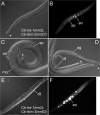A sensitized genetic background reveals evolution near the terminus of the Caenorhabditis germline sex determination pathway
- PMID: 19601967
- PMCID: PMC2945250
- DOI: 10.1111/j.1525-142X.2009.00340.x
A sensitized genetic background reveals evolution near the terminus of the Caenorhabditis germline sex determination pathway
Abstract
Caenorhabditis elegans and Caenorhabditis briggsae are both self-fertile hermaphroditic nematodes that evolved independently from male/female ancestors. In C. elegans, FEM-1, FEM-2, and FEM-3 specify male fates by promoting proteolysis of the male-repressing transcription factor, TRA-1. Phenotypes of tra-1 and fem mutants are consistent with this simple linear model in the soma, but not in the germline. While both XX and XO tra-1(lf) mutants have functional male somas, they produce both sperm and oocytes. Further, all three tra-1; fem double mutants retain the expected male soma, but make only oocytes (the germline fem phenotype). Thus, a poorly characterized tra-1 activity is important for sustained male spermatogenesis, and the fem genes affect germline sexual fate independently of their role in regulating TRA-1. C. briggsae tra-1 mutants are phenotypically identical to their C. elegans counterparts, while the fem mutants differ in the germline: XX and XO C. elegans fem mutants are true females, but in C. briggsae they are self-fertile hermaphrodites. To further explore how C. briggsae hermaphrodites regulate germline sex, we analyzed Cb-tra-1/Cb-fem interactions. Cb-tra-1 is fully epistatic to Cb-fem-2 in the germline, unlike the orthologous C. elegans combination. In contrast, Cb-fem-3 shifts the Cb-tra-1(lf) germline phenotype to that of a nearly normal hermaphrodite in the context of a male somatic gonad. This suggests that Cb-fem-3 is epistatic to Cb-tra-1(lf) (as in C. elegans), and that the normal control of C. briggsae XX spermatogenesis targets Cb-tra-1-independent factors downstream of Cb-fem-3. The effect of Cb-fem-3(lf) on Cb-tra-1(lf) is not mediated by change in the expression of Cb-fog-3, a likely direct germline target of Cb-tra-1. As Cb-fem-2 and Cb-fem-3 have identical single mutant phenotypes, Cb-tra-1 provides a sensitized background that reveals differences in how they promote male germline development. These results represent another way in which C. briggsae germline sex determination is incongruent with that of the outwardly similar C. elegans.
Figures





Similar articles
-
Robust sex determination in the Caenorhabditis nigoni germ line.Genetics. 2025 Apr 17;229(4):iyae207. doi: 10.1093/genetics/iyae207. Genetics. 2025. PMID: 39663849 Free PMC article.
-
fog-2 and the evolution of self-fertile hermaphroditism in Caenorhabditis.PLoS Biol. 2005 Jan;3(1):e6. doi: 10.1371/journal.pbio.0030006. Epub 2004 Dec 28. PLoS Biol. 2005. PMID: 15630478 Free PMC article.
-
Genetic flexibility in the convergent evolution of hermaphroditism in Caenorhabditis nematodes.Dev Cell. 2006 Apr;10(4):531-8. doi: 10.1016/j.devcel.2006.02.002. Dev Cell. 2006. PMID: 16580997
-
RNA and sex determination in Caenorhabditis elegans. Post-transcriptional regulation of the sex-determining tra-2 and fem-3 mRNAs in the Caenorhabditis elegans hermaphrodite.EMBO Rep. 2001 Oct;2(10):899-904. doi: 10.1093/embo-reports/kve209. EMBO Rep. 2001. PMID: 11600454 Free PMC article. Review.
-
Sex determination in the germ line.WormBook. 2007 Mar 5:1-13. doi: 10.1895/wormbook.1.82.2. WormBook. 2007. PMID: 18050498 Free PMC article. Review.
Cited by
-
Robust sex determination in the Caenorhabditis nigoni germ line.Genetics. 2025 Apr 17;229(4):iyae207. doi: 10.1093/genetics/iyae207. Genetics. 2025. PMID: 39663849 Free PMC article.
-
The evolutionary origins and consequences of self-fertility in nematodes.F1000Prime Rep. 2014 Aug 1;6:62. doi: 10.12703/P6-62. eCollection 2014. F1000Prime Rep. 2014. PMID: 25165561 Free PMC article. Review.
-
From "the Worm" to "the Worms" and Back Again: The Evolutionary Developmental Biology of Nematodes.Genetics. 2018 Oct;210(2):397-433. doi: 10.1534/genetics.118.300243. Genetics. 2018. PMID: 30287515 Free PMC article. Review.
-
SPE-44 implements sperm cell fate.PLoS Genet. 2012;8(4):e1002678. doi: 10.1371/journal.pgen.1002678. Epub 2012 Apr 26. PLoS Genet. 2012. PMID: 22570621 Free PMC article.
-
A phylogeny and molecular barcodes for Caenorhabditis, with numerous new species from rotting fruits.BMC Evol Biol. 2011 Nov 21;11:339. doi: 10.1186/1471-2148-11-339. BMC Evol Biol. 2011. PMID: 22103856 Free PMC article.
References
-
- Aono S, Legouis R, Hoose WA, Kemphues KJ. PAR-3 is required for epithelial cell polarity in the distal spermatheca of C. elegans. Development. 2004;131:2865–2874. - PubMed
-
- Chen P, Ellis RE. TRA-1A regulates transcription of fog-3, which controls germ cell fate in C. elegans. Development. 2000;127:3119–3129. - PubMed
-
- Chin-Sang ID, Spence AM. Caenorhabditis elegans sex-determining protein FEM-2 is a protein phosphatase that promotes male development and interacts directly with FEM-3. Genes Dev. 1996;10:2314–2325. - PubMed
Publication types
MeSH terms
Substances
Grants and funding
LinkOut - more resources
Full Text Sources
Research Materials
Miscellaneous

